The synergy between human creativity & AI-based innovation in musical arts allows composers and songwriters to go beyond constraints and discover new musical paths. With machine learning algorithms and data-driven insights, AI empowers artists to unleash their imagination and breathe life into compositions that resonate with audiences on a profound level.
In 2020, AI–driven music composition software generated around USD 229 million. The growth is expected to speed up in the next ten years, reaching a CAGR of 28.6% and generating USD 2.6 billion in incremental revenue by 2022. This reveals how AI impacts current music composition and lyrics-making processes and also investigates how it helps, augments, and challenges the traditional ideas of how music composition is supposed to be.
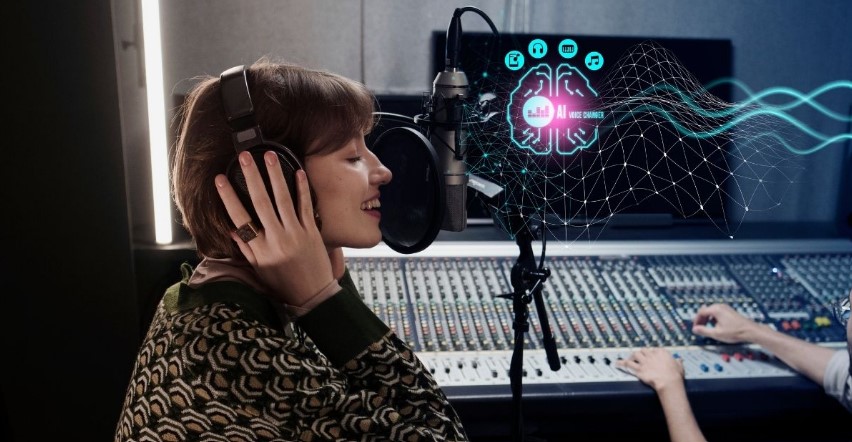
AI in Composing
In music creation, AI facilitates the creation of original works that resonate with musicians’ and composers’ artistic visions. AI-powered technologies analyse vast musical datasets, and composers can input their musical preferences, styles, and inspirations, prompting the system to generate musical ideas.
AI-assisted Music Composition
AI-generated music composition leverages musical motifs, technologies like natural language processing (NLP) and Graphics Processing Unit (GPU) acceleration, assist composers in generating personalised musical ideas and receiving real-time feedback. These technologies have been implemented in various software tools and use cases, such as:
AI-generated Musical Motifs
AI composition uses advanced algorithms to analyse various factors, such as preferred genres, styles, and instruments, to create unique musical ideas. AI provides chord progressions, melodic structures, and rhythmic patterns, and it understands the composer’s artistic vision, which is tailored to their preferences.
Musicians can easily produce personalised soundtracks for videos, ads, TV shows, and similar content. Google’s Magenta algorithms have been trained on vast datasets of musical compositions to generate original motifs based on user input. Composers can experiment with these AI-generated motifs to spark inspiration and enhance their creative process.
NLP for Interpreting Musical Intentions
Composers can convey their creative ideas, concepts, and preferences using ordinary language, and NLP algorithms translate these inputs into musical parameters and instructions that AI systems can understand and execute. This streamlines communication between composers and AI, automating the composition process. However, the translation from language to music involves complexities beyond direct interpretation.
MuseNet, OpenAI’s AI-based composition tool, uses NLP to understand the composer’s intentions. Users can input their preferred musical piece by providing simple textual descriptions, and MuseNet creates the composition according to these inputs. However, it’s important to note that translating natural language directly into music poses significant challenges and limitations.
GPU for Real-time Composition Assistance
GPU acceleration enhances the computational power of AI systems, enabling real-time composition assistance for composers. AI algorithms can analyse vast amounts of musical data and provide instant feedback and suggestions to composers as they work on their compositions.
Google’s Magenta Studio uses GPU acceleration to enhance its deep learning algorithms, allowing composers to generate and manipulate musical sequences in real time. It offers real-time music generation, interactive composition tools, and AI-driven music analysis.
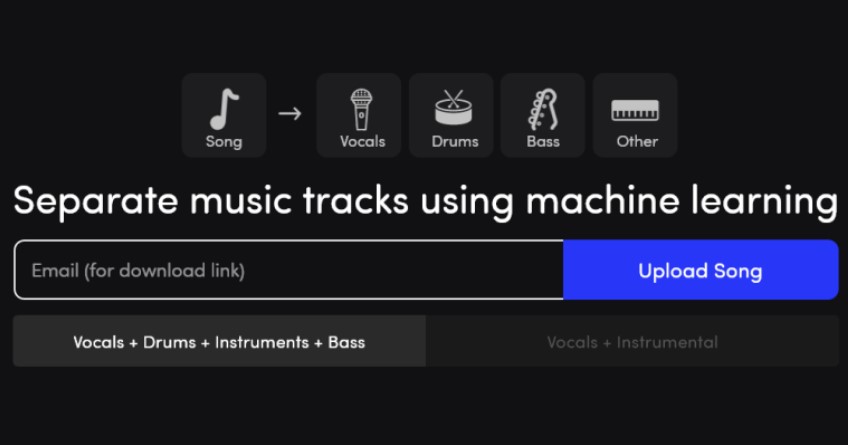
Collaborative Composition of Musicians
It allows multiple musicians to collaborate to create music, with AI technologies like the Internet of Things (IoT) edge computing enabling real-time collaboration among musicians in different locations. Computer vision allows for gesture-based composition interfaces, facilitating intuitive interaction with AI systems. Generative AI algorithms assist in collaboratively generating musical ideas.
IoT Edge Computing for Synchronized Composition Tools
Thanks to granting access to IoT edge computing devices – smartphones, tablets and specialised equipment – composers can join and collaborate online in music projects. These tools establish the communication between devices through a local network (LAN), simultaneously allowing playback, recording, and editing of musical elements.
Splice enables musicians to collaborate across different locations. This allows them to exchange audio files, MIDI data, and project settings instantly. Producers can work safely together without being geographically close, which guarantees successful collaboration and encourages a creative composing approach.
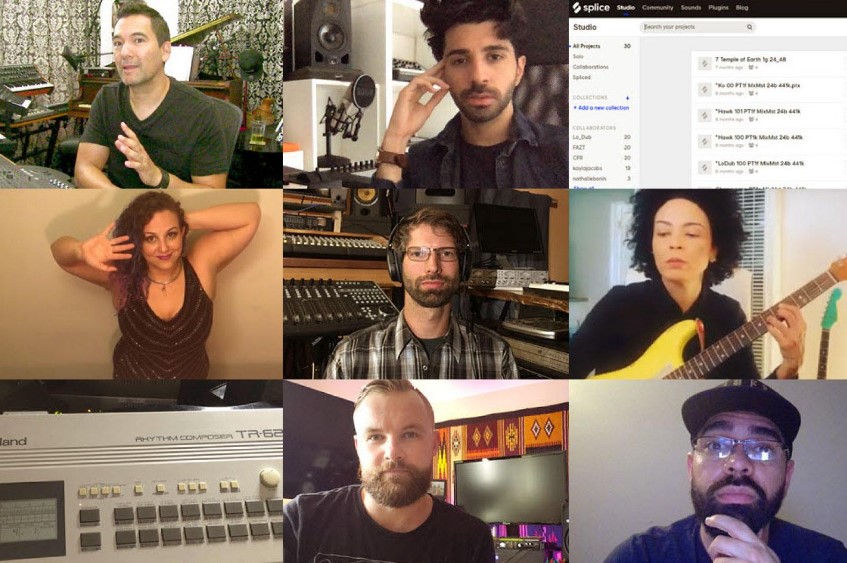
Generative AI for Generating Musical Ideas
Generative AI is like a smart assistant for musicians that provides you with new musical ideas via analysing what they’ve already created and suggesting new opportunities. AI software programs like AIVA musical ideas are mixed and analysed to compose new songs according to the composer’s preferences.
The AI searches for patterns and similarities among the music that the composers have made and use this information to shape new music that everyone will appreciate and enjoy. It’s as if I get to partner with a powerful music producer who can merge our thoughts and transform them into something sensational.
Gesture-Based Composition Using Computer Vision
Computer Vision technology lets composers interact with music software using hand gestures or body movements. This gives composers the power to navigate music software using only their hands or body; they no longer require a computer keyboard or a mouse.
For example, the Leap Motion Controller device tracks hand movements. It’s used with software like GECO MIDI, which lets composers control virtual instruments or change how music sounds by moving their hands. This makes composing music more natural and expressive.
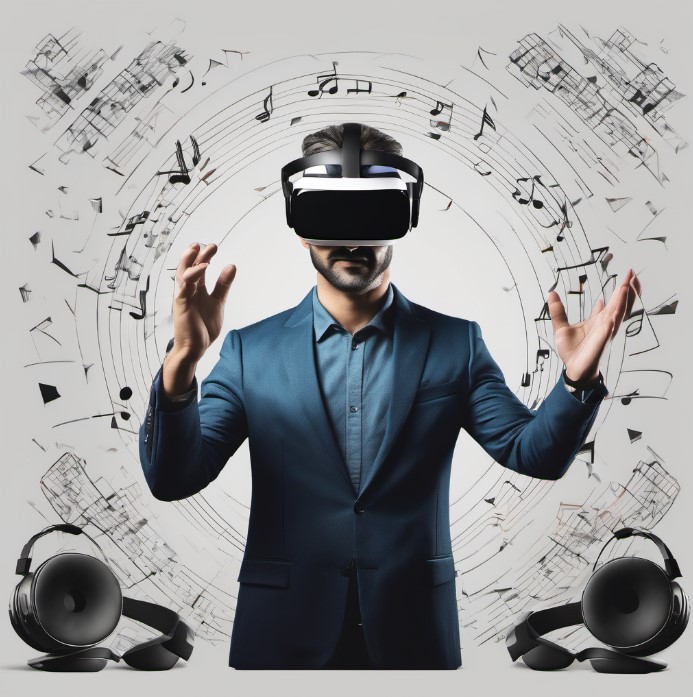
AI in Songwriting
Imagine a world where emotions are translated into melodies, and themes take shape through the artful arrangement of words. The role of AI in songwriting includes every sentiment and every story and finds its voice in the symphony of sound. Musicians and composers can discover the creative potential of artificial intelligence tools for workflow automation and art expression.
Lyric Generation
AI-generated lyrics are a groundbreaking advancement in songwriting. These AI lyrics are created precisely, inspired by original emotions or themes. Songwriters can delve into many emotional factors, like love, nostalgia, or triumph, creating lyrics that resonate deeply with listeners.
NLP for Semantic Understanding:
NLP enables AI applications to understand human languages easily. The concept is similar to teaching AI to grasp the meaning of words and sentences, just as we do. Through NLP, AI systems can comprehensively scan out existing lyrical content and generate lyrics that convey the song’s intended expression, mood, theme, and message.
- Semantic Understanding: NLP enables AI to extract the meaning and the context from which the words in song lyrics are derived. NLP technology can detect different phrases like “love,” “sad,” “happy,” or other emotions that help generate the lyrics in a way that will properly convey the mood or theme.
- Generating Coherent Lyrics: When AI systems understand the semantic structure of language, they may use that knowledge to create grammatically correct and meaningful lyrics with different stylistic features. NLP guarantees that AI-generated lyrics align with the message or theme, making them more meaningful and memorable.
- Enhanced Creativity: With in-depth analysis of existing song lyrics, NLP lets AI discover patterns, motifs, and stylistic elements, essential attributes used in music. This knowledge of the underlying features of the original lyrical style helps the AI technology with the ability to write creative lyrics that are relatable to listeners.
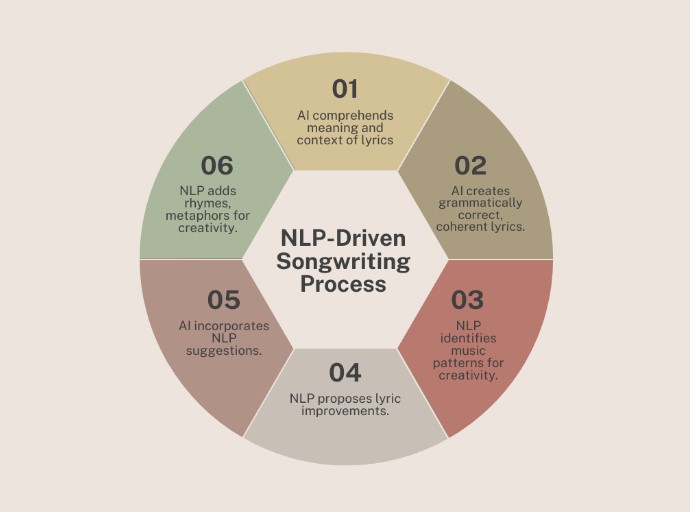
Generative AI for Expressive Lyrics
Generative AI is like a creative brain that helps generate new ideas for lyrics from existing song lyrics and musical patterns. While AI algorithms like GPT-3 by OpenAI can produce coherent and creative lyrics, it’s important to note that the process is not entirely autonomous or flawless. Creating lyrics that deeply resonate with audiences and easily fit into musical compositions remains complex and nuanced.
Taryn Southern collaborated with Amper Music, an AI music composition platform, to co-write and produce the song “Break Free”. While AI generated musical lyrics based on input from Taryn, the final output required human intervention to refine the lyrics, imbuing them with human emotion. This example shows that while AI can contribute valuable insights and ideas, human emotional intelligence is needed in crafting lyrics that truly touch people’s feelings.
NPR’s interview with Taryn Southern where she underscored the need to curate and edit the AI-based content so that it syncs with her artistic vision and resonates with her audience. These opinions thus strengthen the idea that still human influence is the most important factor that leads to a high level of detail and emotional response from the listeners.
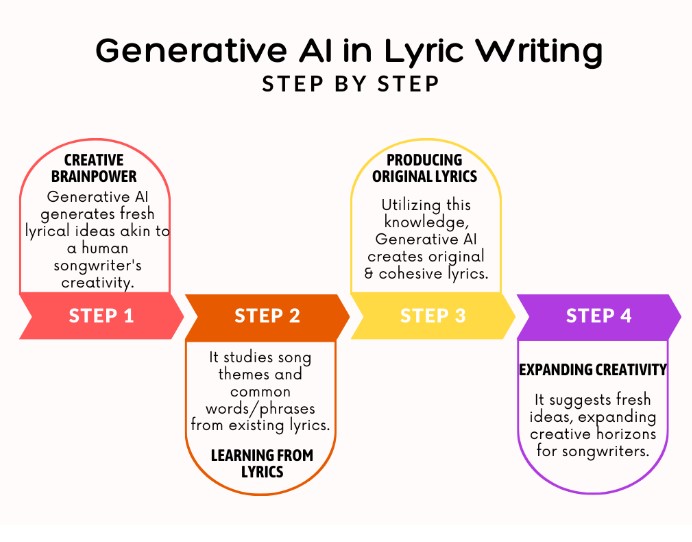
Mood and Theme Analysis
AI-driven algorithms comprehensively analyse images associated with songs like album artwork, music videos and artist photos. With Computer Vision technology, AI can detect and assess visual elements’ mood and theme and suggest songs liked and preferred by users. GPU acceleration lets AI models process large datasets of visual content quickly, delivering music that resonates with the user’s emotions.
Shazam uses computer vision algorithms to analyse visual content like album covers and posters, extracting features indicative of specific songs for accurate identification. GPU acceleration speeds up this process, enabling Shazam to efficiently process large datasets of visual content. This collaboration of AI and GPU technology ensures users receive relevant information about identified songs, including artist details and lyrics, enhancing the user experience in music recognition applications like Shazam.

What Can Technolynx Offer You as a Software Company?
At TechnoLynx, our cutting-edge software solutions use machine learning algorithms & deep neural networks to empower companies across various industries. With AI-powered technologies, software is more productive and efficient throughout the development lifecycle. We help our clients by focusing on innovation and creativity, automating routine tasks and optimising code performance, and accelerating the software development process.
Moreover, our AI-powered designs focus on providing insightful analytics and predictive capabilities, allowing our clients to make data-driven decisions and adapt to changing market demands effectively. Whether you’re seeking to improve user experience, optimise resource allocation, or enhance security measures, our solutions are designed to meet your evolving needs.
Partner with TechnoLynx to unlock AI’s full potential in software development. Contact us today to explore how our transformative technologies can revolutionise your software projects and propel your company towards success. Let’s embark on a journey of innovation together.

Final Thoughts
In the end, the development of AI in musical composing and songwriting implies that creative thinking is unlimited, and AI is the key to unlocking new opportunities. TechnoLynx leverages its technological prowess in AI to equip musicians and songwriters with world-class products that extend their creativity and spark musical ingenuity.
References
- Anon, (n.d.). Leap motion controller 2 – Ultraleap. [online] Available at: https://leap2.ultraleap.com/leap-motion-controller-2/ [Accessed 16 Feb. 2024].
- openai.com. (n.d.). MuseNet. [online] Available at: https://openai.com/research/musenet.
- Sandzer-Bell, E. (2023). How to Use Google Magenta Studio to Create AI Riffs. [online] AudioCipher. Available at: https://www.audiocipher.com/post/google-magenta.
- splice.com. (n.d.). Community. [online] Available at: https://splice.com/features/community [Accessed 16 Feb. 2024].












